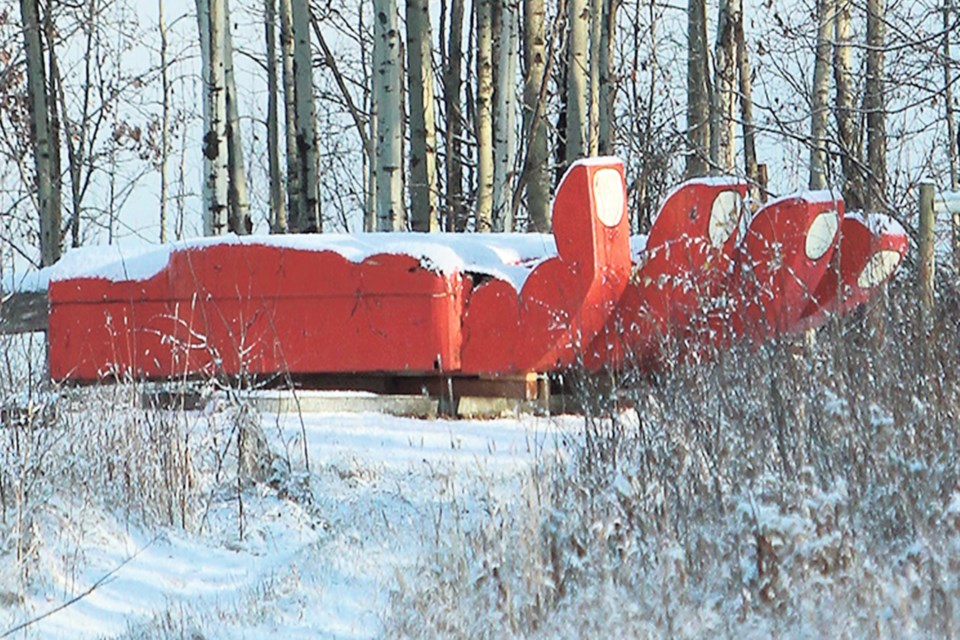ATHABASCA - If you happen to wander down to Mossy Trails south of Athabasca and visit the Johnson family, you may catch a glimpse of what appears to be a giant, red hand poking out of the trees — there's no need to be alarmed, that's exactly what it is — but it's also a piece of art.
It sits palm-side up, like the hand of giant mythological warrior, lost in battle before wandering off cradling his injured arm, but in reality, it is a sculpture by Nickelas Johnson, that was commissioned by the Edmonton Arts Council and then purchased by the city in 2012. Recently, it was decommissioned and needed to find a new home, so Johnson had it transported to his parents' farm near Colinton in early November.
“I was invited to be a part of a temporary art project in Edmonton with 14 other artists,” said the 40-year-old artist, who lives in Edmonton. “The project was called Dirt City Dream City and the goal was to get the artists to spend an immersive amount of time down in an area in Edmonton called The Quarters because at the time, I guess it still is, but at the time especially, it was a rougher area of town.”
The Quarters is located around Jasper Ave. and 95 St., and artists were challenged to use the history of the area and the people living there as inspiration for their installations which ranged from impromptu violin performances to Johnson’s giant, red hand and a giant dreamcatcher.
“The community response was really pretty amazing and overwhelming — I don't know how many people approached the city — but people approached the city and said, we want this to be a permanent thing,” he said. “So, the city bought it based on the response from the community, that was in 2012 and it was in the permanent collection, which is a funny phrase to say.”
Made primarily out of two-by-12 boards, and a couple of brackets on a deck then painted red, the piece was named to reflect Johnson’s impression that there are areas in any town or city where people down on their luck tend to gather; people who may not be regarded as useful in mainstream society.
“I called it Ripp’d Off and Red because it was literally a ripped off hand, but also, it is a feeling of being ripped off,” said Johnson. “So, that was kind of symbolic of these people in our society that we disregard. I'm trying to reflect how I imagined that would feel.
“It's symbolic both of anger and reference to a period in our history, not so long ago, of more overt racism. The severed hands (have) become a symbol in my lexicon for having your usefulness amputated because as someone who makes things — everybody who has hands uses them all the time — but for someone who creatively, and professionally makes things, losing my hands is just a terrifying thing.”
Now, the piece is resting in a field at his parents' farm surrounded by a few trees and some other sculptures he has created, as he explores his relationship with country versus city living.
“Mossy Trails is their property. We've been piecing together an outdoor gallery kinda figuring out how to integrate my art practice into the life outside of the city that I prefer,” he said. “Pre-COVID, I felt like living in the city was necessary for my career, but I never really appreciated it the way I like living in the country. So, I'm trying to figure that out and Mossy Trails is a step towards that; at least that's what it is for me.”
The sculpture, like most of Johnson’s larger pieces, will eventually return to the earth as intended.
“I wanted to see how it weathered. I'm very interested in how nature changes things like art, because a lot of attitudes towards art are that it's so sacred and precious, we have to preserve it behind glass, keep it perfect,” said Johnson.
“I want it to change. I want it to have a life. I want the way that seasons and years change us I am interested in seeing what happened to my artwork, instead of thinking that it's a precious thing.”
When the City of Edmonton bought the piece in 2012 Johnson did do some preservation work and will give it a bit more work in the spring, but after that it will become Mother Nature’s to take.
“I am pretty interested in the spring, giving it one last conservation job to prolong its life in the bush but again, that's with the knowledge that there's no way of stopping the elements and I'm not gonna put it in glass box,” he said.
As to whether the sculptures at Mossy Trails will be open for public viewing one day, Johnson said he's not sure, but somewhere out there in the bush is giant, red hand, palm up to the sky, a place for wildlife and nature to leave their indelible mark.
“There's moose scrapes and owl feathers landing on it; it's a very fascinating experience for me,” Johnson said. “What that means for Athabasca and how open it will be to people is what we're figuring out.”
Some of Johnson’s other work will be for sale at the revamped Royal Bison Art and Craft Fair, running Nov. 27 to Dec. 9 in a virtual format. His "table” is linked to his website smokeydraws.com where he is still preparing for the fair.
Heather Stocking, TownandCountryToday.com
Follow me on Twitter @HLSox



